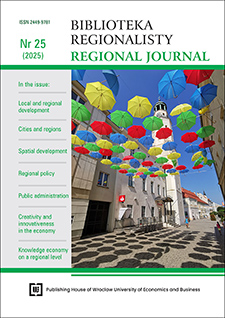Impact of depopulation of municipalities in the Świętokrzyskie voivodeship on green infrastructure changes
DOI:
https://doi.org/10.15611/br.2025.1.04Keywords:
green infrastructure, demographics, synthetic measure, CRITIC-TOPSIS methodAbstract
Aim: The aim is to assess and identify the challenges of depopulation in the municipalities of Świętokrzyskie Voivodeship and to evaluate the possibilities of revitalizing green spaces with limited resources. The study focuses on the impact of depopulation on the quality of green infrastructure.
Methodology: The study used literature analysis, statistical methods, and TOPSIS, collecting empirical data from municipalities in Świętokrzyskie Voivodeship in 2014 and 2022, which allowed us to capture the dynamics of the phenomena and monitor conjunctural changes.
Results: The study of the impact of depopulation on green infrastructure in municipalities of Świętokrzyskie Voivodeship showed positive changes in the quality of green spaces, promotion of sustainable development, revitalization of urban spaces, and creation of new green spaces in response to demographic changes.
Conclusions and recommendations: It is recommended to continue investing in green infrastructure, especially in areas with lower concentrations of it and to monitor changes in green space distribution and demographics.
Originality/value: The study analyzes the relationship between demographics and green infrastructure in municipalities, using a synthetic measure to compare the years 2014 and 2022, making it possible to assess their mutual impact on ecosystems.
Downloads
References
Acevedo, S., & José, C. (2019). Multi-Response Optimization of Porous Asphalt Mixtures Reinforced with Aramid and Polyolefin Fibers Employing the CRITIC-TOPSIS Based on Taguchi Methodology. Materials, 12, 3789.
Anselin, L. (1995). Local Indicators of Spatial Association – LISA. Geographical Analysis, 27(2), 93-115.
de Manuel, B. F., Méndez-Fernández, L., Peña, L., & Ametzaga-Arregi, I. (2021). A New Indicator of the Effectiveness of Urban Green Infrastructure Based on Ecosystem Services Assessment. Basic and Applied Ecology, 53, 12-25. https://doi.org/10.1016/j.baae.2021.02.012
Du, X., Wang, Y., & Chen, F. (2024). Evaluation of Coal-Resource-Based Cities Transformation Based on CRITIC-TOPSIS Model. Sustainable Cities and Society, 103, 105271. https://doi.org/10.1016/j.scs.2024.105271
Gebreyesus, T., Borgemeister, Ch., Herrero-Jáuregui, C., & Kelboro, G. (2024). Transforming Urban Air Quality: Green Infrastructure Strategies for the Urban Centers of Ethiopia. Environmental Pollution, 363, Part 2, 125244. https://doi.org/10.1016/j.envpol.2024.125244
Karanikola, P., Panagopoulos, T., Tampakis, S., Simoglou, G., & Tzelepi, A. (2023). Perceptions of Urban Green Infrastructure in Two Contrasting Municipalities of the Metropolitan Area of Athens, Greece. Nature-Based Solutions, 3, 100063. https://doi.org/10.1016/j.nbsj.2023.100063
Kaveh, S., Habibi, A., Nikkar, M., & Aflaki, A. (2024). Optimizing Green Infrastructure Strategies for Microclimate Regulation and Air Quality Improvement in Urban Environments: A Case Study. Nature-Based Solutions, 6, 100167. https://doi.org/10.1016/j.nbsj.2024.100167
Kuo, T. (2017). A Modified TOPSIS with a Different Ranking Index. European Journal of Operational Research, 260(1), 152-160. https://doi.org/10.1016/j.ejor.2016.11.052
Lin, T., Cai, J., Geng, H., Zheng, Y., Zeng, Z., & Zheng, Y. (2024). Incorporating Suburban Cropland into Urban Green Infrastructure: A Perspective of Nature-Based Solutions in China. Nature-Based Solutions, 5, 100122. https://doi.org/10.1016/j.nbsj.2024.100122
Longley, P., Goodchild, M. F., Maguire, D. J., & Rhind, D. W. (2006). GIS. Teoria i praktyka. Wyd. Naukowe PWN.
Marques, A. L., & Tanus Benatti Alvim, A. (2024). Metropolitan Fringes as Strategic Areas for Urban Resilience and
Sustainable Transitions: Insights from Barcelona Metropolitan Area. Cities, 150, 105018. https://doi.org/10.1016/j.cities.2024.105018
Nygaard, Ch. A. (2024). Green Infrastructure and Socioeconomic Dynamics in London Low-Income Neighbourhoods: A 120-
-year Perspective. Cities, 144, 104616. https://doi.org/10.1016/j.cities.2023.104616
Pilar Alonso, M. P., Gargallo, P., Lample, L., López-Escolano, C., Miguel, J. A., & Salvador, M. (2024). Measuring the Relationship Between Territorial Exclusion and Depopulation – A Municipal Classification Proposal to Guide Territorial Balance. Journal of Rural Studies, 111, 103421. https://doi.org/10.1016/j.jrurstud.2024.103421
Popławski, Ł., Grzelak, A., & Dziekański, P. (2024). Still Trade-Off or Already Synergy Between Waste Management and the Environment? In the Light of Experience at the Level of the Voivodeship in Poland. Economics and Environment, 91(4), 886. https://doi.org/10.34659/eis.2024.91.4.886
PQStat 1.8.2
Ruan, T., Xu, Y., Jones, L., Boeing, W. J., & Calfapietra, C. (2023). Green Infrastructure Sustains the Food-Energy-Water-Habitat Nexus. Sustainable Cities and Society, 98, 104845. https://doi.org/10.1016/j.scs.2023.104845
Sampson, N. R., Webster, N. J., Nassauer, J. I., & Schulz, A. J. (2019). Adapting Social Surveys to Depopulating Neighborhoods. Landscape and Urban Planning, 181, 45-50. https://doi.org/10.1016/j.landurbplan.2018.09.009
Sánchez, B., Velázquez, J., Pérez, R., Jorge-Vázquez, J., Gómez, I., Nañez Alonso, S. L., Chivite-Cebolla, M. P., & Alexandre Castanho, R. (2024). Preventing Depopulation by Improving Technological Endowment: A Methodology for Identifying Priority Municipalities. Cities, 150, 105066. https://doi.org/10.1016/j.cities.2024.105066
San-Martín González, E., & Soler-Vaya, F. (2024). Depopulation Determinants of Small Rural Municipalities in the Valencia Region (Spain). Journal of Rural Studies, 110, 103369. https://doi.org/10.1016/j.jrurstud.2024.103369
Sompolska-Rzechuła, A. (2021). Selection of the Optimal Way of Linear Ordering of Objects: Case of Sustainable Development in EU Countries. Statistika, 101, 24-36.
Statistica 13.3
Upton, G., & Fingleton, B. (1985). Spatial Data Analysis by Example. Wiley.
Vega, A., Aguaron, J., Garcia-Alcaraz, J. L., & Moreno-Jimenez, J. M. (2014). Notes on Dependent Attributes in TOPSIS. Procedia Computer Science, 31, 308-317.
Wang, B., Yang, H., Bi, Ch., & Feng, Y. (2023). Green Infrastructure and Natural Resource Utilization for Green Development in Selected Belt and Road Initiative Countries. Resources Policy, 85, Part A, 103758. https://doi.org/10.1016/j.resourpol.2023.103758
Wang, C., Wang, L., Gu, T., Yin, J., & Hao, E. (2023). CRITIC-TOPSIS-Based Evaluation of Smart Community Safety: A Case Study of Shenzhen, China. Buildings, 13, 476. https://doi.org/10.3390/buildings13020476
Wen, H., Hu, K., Nghiem, X. H., & Acheampong, A. O. (2024). Urban Climate Adaptability and Green Total-Factor Productivity: Evidence from Double Dual Machine Learning and Differences-in-Differences Techniques. Journal of Environmental Management, 350, 119588. https://doi.org/10.1016/j.jenvman.2023.119588
Wu, X., Zhang, J., Geng, X., Wang, T., Wang, K., & Liu, S. (2020). Increasing Green Infrastructure-Based Ecological Resilience in Urban Systems: A Perspective from Locating Ecological and Disturbance Sources in a Resource-Based City. Sustainable Cities and Society, 61, 102354. https://doi.org/10.1016/j.scs.2020.102354
Wu, Y., Dennis Wei, Y., Liu, M., & García, I. (2023). Green Infrastructure Inequality in the Context of COVID-19: Taking Parks and Trails as Examples. Urban Forestry & Urban Greening, 86, 128027. https://doi.org/10.1016/j.ufug.2023.128027
Zabel, A., & Häusler, M. M. (2024). Policy Instruments for Green Infrastructure. Landscape and Urban Planning, 242, 104929. https://doi.org/10.1016/j.landurbplan.2023.104929
Zeng, J., Lin, G., & Huang, G. (2021). Evaluation of the Cost-Effectiveness of Green Infrastructure in Climate Change Scenarios Using TOPSIS. Urban Forestry & Urban Greening, 64, 127287. https://doi.org/10.1016/j.ufug.2021.127287
Zhao, H., Gu, B., Zhou, L., Li, X., & Gu, X. (2024). Evaluating the Demand for Urban Green Infrastructure: A Residential Perspective. Cities, 153, 105271. https://doi.org/10.1016/j.cities.2024.105271
Downloads
Published
Issue
Section
License
Copyright (c) 2025 Paweł Dziekański

This work is licensed under a Creative Commons Attribution-ShareAlike 4.0 International License.
Accepted 2025-03-17
Published 2025-06-27







